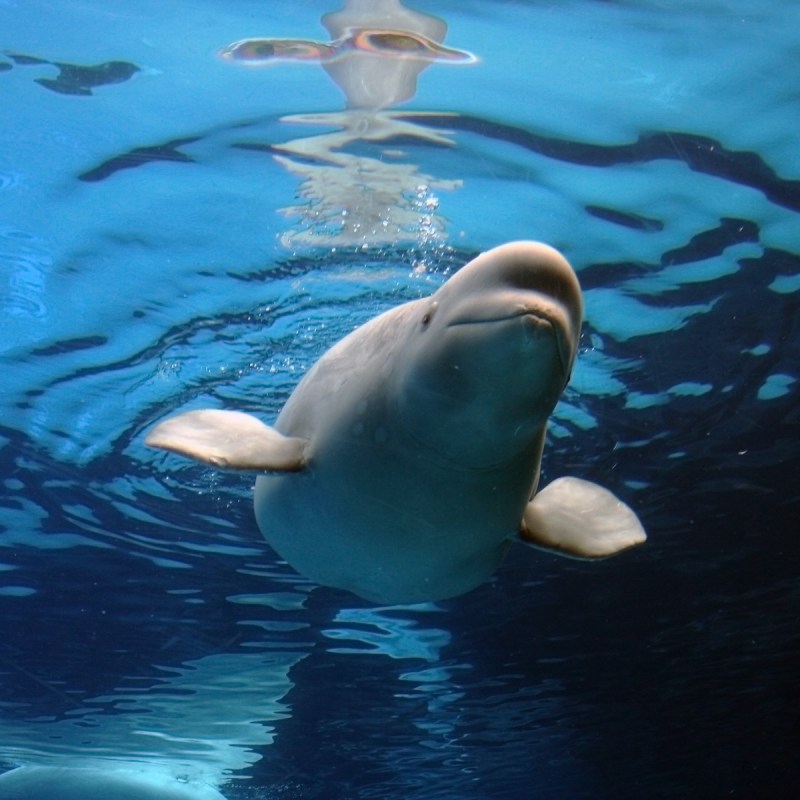
Up to 55,000 beluga whales are migrating to warmer waters, as they do each year, and you can watch them live.
Videos by TravelAwaits
The livestream is produced through a partnership between Arctic conservation group Polar Bears International and nature live streaming network explore.org. It is broadcasted from Polar Bears International’s research vessel, Delphi, at the Churchill River estuary, where the river flows into the Hudson Bay in northeastern Canada. The goal of broadcasting a livestream from the Beluga Whale Live Cam is to educate people about sea ice so they better understand its importance to the Arctic ecosystem.
Sea ice “is to the ocean what soil is to the forest,” said Alysa McCall, director of conservation outreach and staff scientist at Polar Bears International, according to Live Science.
“Sea ice is a critical habitat for Arctic species,” McCall continued. “Walrus and seals use sea ice as a refuge to haul out on, seals give birth on sea ice, and beluga whales use sea ice for protection from orcas. Every species in the Arctic, in the ocean, is supported by Arctic sea ice, because within Arctic sea ice grows algae which is like the plants of the north.”
Although the amount of Arctic sea ice is shrinking rapidly due to the warming climate, there is good news too: Sea ice can potentially recover quickly if the climate cools, McCall said.
“When we get our carbon emissions at a more sustainable level and we start moving to greener energy more broadly, we know that sea ice will bounce back,” McCall said. “Actions you take now to reduce carbon emissions and switch to solar energy, wind energy, and get these big corporations on board with being more sustainable absolutely have a positive impact on sea ice, which positively impacts all the animals that rely on it.”
The livestream began on July 15, which is Arctic Sea Ice Day.
The ‘Canary Of The Sea’
“Beluga Whales, or Delphinapterus leucas, are known for their white color and range of vocal sounds, earning them the title of ‘canary of the sea,’” according to the National Oceanic and Atmospheric Administration Fisheries (NOAA). “They are very social animals, forming groups to hunt, migrate, and interact with each other.”
Considering that the whales live in Arctic and sub-Arctic waters, it isn’t surprising that they have a thick layer of blubber and thick skin to help them live in the freezing waters.
Another interesting feature is that instead of a dorsal fin, belugas have a dorsal ridge, which allows them to swim easily under sheets of floating ice. Indeed, the genus name Delphinapterus translates to “dolphin without a fin.”
On average, beluga whales weigh around 3,100 pounds and reach lengths of up to 16 feet. They have a lifespan of approximately 90 years.
Their diet includes octopus, squid, crabs, shrimp, clams, snails, and sandworms. They also eat a variety of fish, including salmon, eulachon, cod, herring, smelt, and flatfish.
All beluga whale populations are protected under the Marine Mammal Protection Act (MMPA). Importantly, NOAA Fisheries has designated some beluga whale populations in Alaska and Russia as “depleted,” which means their numbers have fallen below what is considered optimum sustainable population levels.
The Beluga Whale Livestream
The livestream from the so-called “beluga cams” begins each year as a group of approximately 55,000 beluga whales migrate to the shallow waters of the Hudson Bay.
In the winter, the bay is locked by ice, said Stephen Petersen, director of conservation and research at Canada’s Assiniboine Park Conservancy, according to Live Science. On the other hand, the beluga whales travel to the area in the summer when the water is warmer.
The whales may find that the sheltered waters of the bay offer protection from killer whales, Petersen told Live Science. Plus, the estuaries provide belugas with ample food supplies.
What’s more, scientists also believe the whales return to the warm, low-salt waters from the Churchill River estuary to give birth. That’s because those warmer waters are ideal for newborn calves who lack a thick blubber layer to protect them from cold water.
There are two cameras aboard Polar Bears International’s beluga boat Delphi — short for Delphinapterus, naturally — to provide different views of the whales. The first camera is on the ship’s deck while the second is below the water’s surface. That camera even captures the whales’ calls.
You can watch the livestreams here.
How You Can Help With Research
While some beluga whale populations are low, the population that migrates into the Hudson Bay each year has a healthy size. One of the goals of the livestream from the beluga cams is to work to maintain that population’s health, Petersen explains.
“We want to build up monitoring so if threats appear or if that population changes, we can see that before we get to a critical spot,” Petersen continues.
Toward that goal, Petersen runs the Beluga Bits citizen science project.
Here’s how it works: Each year, beluga cam viewers can collect screenshots of the whales they see on the Delphi livestreams in July and August. Then, throughout the year, they can help identify individual whales in the images at zooniverse.org.
This work helps scientists learn more about beluga whales, including whether or not the whales return to the same place each year.
You can learn more about Beluga Bits here and zooniverse.org here.
If you’d like to learn more about seeing whales in person, be sure to also read:
